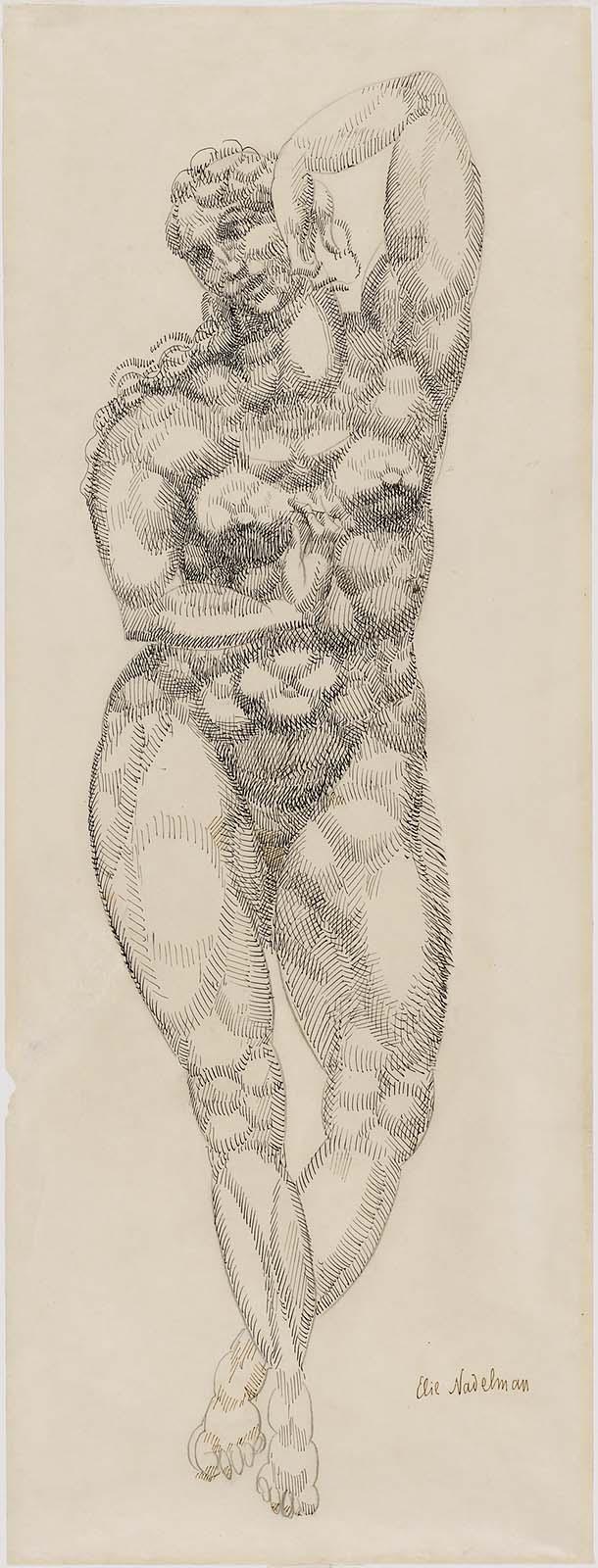Advanced Search 

Standing Female Nude
Elie Nadelman (American, 1882–1946)
1905–08
Medium/Technique
Pen and ink over graphite pencil underdrawing on cream colored Asian paper
Dimensions
Sheet: 53.3 x 19.1 cm (21 x 7 1/2 in.)
Framed: 78 x 44 x 3.5 cm (30 11/16 x 17 5/16 x 1 3/8 in.)
Framed: 78 x 44 x 3.5 cm (30 11/16 x 17 5/16 x 1 3/8 in.)
Credit Line
Charles H. Bayley Picture and Painting Fund
Accession Number2006.846
NOT ON VIEW
CollectionsAmericas, Prints and Drawings
ClassificationsDrawings
This drawing predates Elie Nadelman's emigration to America. Born in Poland, he studied briefly in Warsaw before going to Munich where in 1902 he encountered the astounding collection of Classical antiquities housed in the Glyptothek. By 1904, he had moved to Paris where he would live for next decade. He was drawn to the power of Classical and Renaissance sculpture, which he studied in the Louvre; yet, he was fully engaged with avant-garde activities. From 1905-08, the period in which he made the present drawing, he exhibited at the Salon des Indépendants and at the Salon d'Automne. In his first solo exhibition, at the Galerie Druet, he showed, among other things, a series of full-length standing nudes in bronze and plaster. The drawing may well have served him in the creation of those figures.
In a statement widely cited because of its truth, Nadelman said in 1910, "I employ no other line than the curve, which possesses freshness and force. I compose the curves so as to bring them in accord in opposition to each other." This practice is quite evident in the present drawing. Beginning with a broadly drawn pencil underdrawing, Nadelman arranged the main contours of the figure in rhythms and counterpoints. At this stage the drawing would have resembled the stylized outline drawings that he sometimes deemed complete. Nadelman's underdrawing was made with sufficient pressure that it is easily seen. Whereas many other artists make very light underdrawings that are inconspicuous, easily inked over, or readily erased, Nadelman uses his as part of the complete image. Here pencil lines very clearly define the feet, hands, and other features.
Nadelman's sculptural sense came into full play as he used a fine drafting pen to apply ink in narrow bands of parallel hatching that give the figure formidable heft, yet a bizarre, mannered, over-defined physiognomy. Even her breasts appear to be subdivided into smaller muscle groups. The numerous resultant highlights give her body the appearance of being a hard substance with a polished surface, similar to sculpture in stone or bronze.
It has been observed that Nadelman derived the pose from Michelangelo's "Dying Slave" intended for the tomb of Pope Julius II (Louvre). It might be more accurate to say that he took the Slave as his point of departure, for he altered nearly every aspect of the composition. Besides transforming the figure into a woman, he changed the positions of the arms, hands, and left leg. He also relaxed the figure, reducing the backward thrust of the shoulders and the tension in the abdomen. The woman's ample hips and thighs accentuate the contrapposto distribution of her weight. Her left arm comes to the side of her head rather than reaching behind it. The back of her hand rests against her temple. Her right shoulder is lowered, and she gestures toward her breast.The overall result, however, is a less ecstatic and less weighty figure figure than that of Michelangelo.
In a statement widely cited because of its truth, Nadelman said in 1910, "I employ no other line than the curve, which possesses freshness and force. I compose the curves so as to bring them in accord in opposition to each other." This practice is quite evident in the present drawing. Beginning with a broadly drawn pencil underdrawing, Nadelman arranged the main contours of the figure in rhythms and counterpoints. At this stage the drawing would have resembled the stylized outline drawings that he sometimes deemed complete. Nadelman's underdrawing was made with sufficient pressure that it is easily seen. Whereas many other artists make very light underdrawings that are inconspicuous, easily inked over, or readily erased, Nadelman uses his as part of the complete image. Here pencil lines very clearly define the feet, hands, and other features.
Nadelman's sculptural sense came into full play as he used a fine drafting pen to apply ink in narrow bands of parallel hatching that give the figure formidable heft, yet a bizarre, mannered, over-defined physiognomy. Even her breasts appear to be subdivided into smaller muscle groups. The numerous resultant highlights give her body the appearance of being a hard substance with a polished surface, similar to sculpture in stone or bronze.
It has been observed that Nadelman derived the pose from Michelangelo's "Dying Slave" intended for the tomb of Pope Julius II (Louvre). It might be more accurate to say that he took the Slave as his point of departure, for he altered nearly every aspect of the composition. Besides transforming the figure into a woman, he changed the positions of the arms, hands, and left leg. He also relaxed the figure, reducing the backward thrust of the shoulders and the tension in the abdomen. The woman's ample hips and thighs accentuate the contrapposto distribution of her weight. Her left arm comes to the side of her head rather than reaching behind it. The back of her hand rests against her temple. Her right shoulder is lowered, and she gestures toward her breast.The overall result, however, is a less ecstatic and less weighty figure figure than that of Michelangelo.
DescriptionPen and black ink modeling over graphite pencil outlines, with signature and back foot in pen and brown ink.
InscriptionsSigned lower right in pen and brown ink: Elie Nadelman
ProvenancePrivate collection (Paris); Galerie JGM (Paris); Private collection (New York); Beth Urdang Gallery (Boston); from whom purchased by MFA, 22 March 2006.
